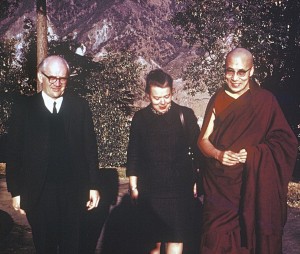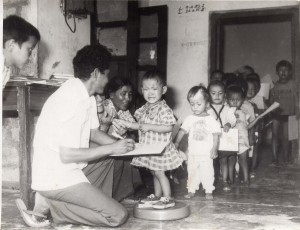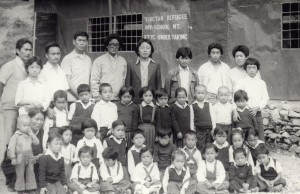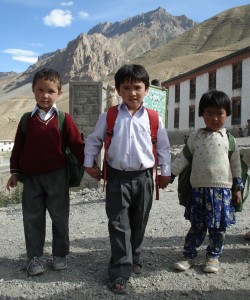- Who We Are
- History of TRAS
- Mission Statement
- How TRAS Works
- Philosophy of Assistance
- Videos
- Annual Financial Reports
The Trans-Himalayan Aid Society (TRAS) is a registered Canadian charity (#130620743RR0001), founded in Vancouver in 1962, which supports the health and education of children and youth in northern India and Nepal. In the past, TRAS has also funded projects in Tibet.
TRAS raises funds for Himalayan partner organizations who implement health and education projects in their own communities.
TRAS raises funds year-round through individual donations as well as through fundraising and educational events that raise awareness about the plight of Himalayan children and youth and their need for continued support.
TRAS has no overseas staff and does not send volunteers abroad, preferring to work with local partners in the Himalayas. TRAS uses the local expertise and materials to address some of the social, economic, medical and environmental needs of this region.
Who We Are
Board of Directors
- Dorothea Leach, Patron
- Dr. Anthony Phillips, Honorary Patron
- Russil Wvong, President
- Daphne Hales, Vice-President
- Kevin Yuen, Treasurer
- Frank Beck
- Lynn Beck
- Abby Fitch
- Jennifer Hales
- Videsh Kapoor
- Megha Shakya
- Sanjeev Singh
All TRAS Directors serve as volunteers.
Staff
TRAS has a single part-time employee, Joanne MacLeod. To reach the office please call 604-224-5133 and leave a message or send an email to info@tras.ca. Both the phone and emails are monitored regularly.
Volunteers
- Beck Lamb, Newsletter Layout
- Maria Rubinchik, Website Manager
History of TRAS
TRAS was founded in 1962 by George and Inge Woodcock of Vancouver in response to the plight of Tibetan refugees who had fled from their homeland after the Chinese communist occupation of Tibet and the failure of the Tibetan uprisings in Lhasa in 1959.
The Tibetans traveled to neighboring countries of India, Nepal and Bhutan under great hardship, across some of the world’s highest and most rugged terrain, fleeing with virtually no possessions. Many died on the way, so that by the time the approximately 80,000 exiles reached safety, there were many orphans amongst their number.

It is to their credit that these already poor countries took in the refugees. The Indian Government helped many Tibetans to settle in old British hill stations that had been abandoned after independence.

George Woodcock, one of Canada’s most prolific and honoured writers, and his wife, Inge, were in India in 1961, conducting research for his book Faces of India. During this trip they happened to meet Tibetan refugees who invited them to visit some of the early Tibetan settlements and introduced them to His Holiness the Dalai Lama.
Seeing the plight of children sleeping on the cement floors of old bungalows, with one blanket for five in the freezing Himalayan winter, the Woodcocks realized that immediate help was needed.
They returned to Vancouver and founded the Tibetan Refugee Aid Society (TRAS) in 1962 to assist displaced Tibetans in India and Nepal. With TRAS support, a successful sponsorship program for the children was started, homes were bought, renovated and furnished, and a small health clinic was built. As the Tibetans identified needs, TRAS provided funds to address them – a roof for a school, housing for old and sick refugees who could not do the backbreaking work on the military roads which India was pushing through the hills, a job commonly given to the Tibetan refugees.

From the start, TRAS worked on long-term solutions to the Tibetan refugee problem, co-operating with other relief organizations from around the world. Early settlements were founded in the Himalayan hills in northern India, where, under the leadership of older, experienced people, the refugees maintained themselves by a combination of horticulture and traditional arts and crafts. TRAS supplied many of these small communities with the financial support they needed to carry out their plans for housing, sanitation, schooling, health, agriculture and crafts. TRAS was also instrumental in helping to organize a central agency for marketing the fine Tibetan carpets, which have become world famous for their beauty and quality.

The vast majority of Tibetan refugees still remained unsettled, however, and it was impossible to accommodate them in the already overcrowded northern parts of India. The Indian Government made available large tracts of undeveloped scrub jungle in southern India. In spite of the added problems of a climate and agricultural conditions completely foreign to high-mountain people, including raids by wild elephants, the Tibetans worked hard and successfully to create viable settlements. TRAS co-operated with Indian and international agencies to support these communities.
In 1970 the work of TRAS was considerably expanded when the Canadian International Development Agency (CIDA) agreed to support TRAS by giving matching funds for those raised from private sources. Schools, hospitals, housing, irrigation, TB control, agricultural training, and rat-proof grain warehouses were some of the projects undertaken by TRAS, along with the continuing sponsorship programs for children and the elderly.

By the late 1970s, these Tibetan settlements were well on the way to self-sufficiency. One measure of success was seen in a settlement of several thousand Tibetans who initially owned one bicycle collectively. However, within a few years nearly every family had a bicycle and the State Bank of India was asking if it could open a branch on the settlement. It was time for TRAS to move on.
Since the beginning of the development of the large settlements in the south, TRAS had regularly offered services to the surrounding Indian villages. TRAS now decided to concentrate the Society’s work in the trans-Himalayan region, changing its name to the Trans-Himalayan Aid Society to reflect its new mandate of supporting local Indians and Nepalis, as well as Tibetans, in the Himalayas.
In northern India, TRAS selected areas in the Onkarnath region, Kullu Valley and the Kumaon hills for integrated rural development projects, and provided many villages with the funds to improve their health, education, agriculture, and reforestation programs. In the late 1980s, a similar project was started in the Annapurna region of Nepal. These projects have been very successful and provide TRAS with the experience and knowledge to support other small, grass-roots development initiatives in areas where little support has been offered before.

Since 1962, TRAS has given millions of dollars to a range of projects in the Himalayas: the building of settlements, schools and homes for children and the elderly, vocational training projects, environmental, agricultural and health programs and the preservation of indigenous arts and culture. Today, TRAS concentrates on supporting health and educational projects for children and youth in the Himalayas.

Mission Statement
The Trans-Himalayan Aid Society (TRAS) is a Vancouver-based non-profit international development organization that seeks to improve the health and education of children and youth in the Himalayan regions of India and Nepal.
TRAS holds no political or religious affiliations, and assists communities on the basis of humanitarian need.
How TRAS Works
Since 1962, TRAS has developed a network of partner organizations in India, Nepal, and Tibet that implement health care and education projects in their communities.
Projects approved and funded by TRAS are planned and executed by local communities in the Himalayas: they know best what they need.
Project proposals come directly from partner organizations in the field to TRAS’s Board of Directors. The Board accepts projects that:
- fit TRAS’s mandate of supporting the health and education of children and youth in the Himalayan regions of India, Nepal and Tibet
- will be implemented by local Himalayan partners with the capacity to see the projects through to successful completion
- will fit within TRAS’s budgetary constraints
TRAS raises funds year round from individual donors and through regular fundraising and educational events. TRAS relies on the generosity of donors to continue its work for Himalayan people.
TRAS sends no staff or volunteers abroad, preferring to work with local partners in the Himalayas, using local expertise and materials, to address some of the social, economic, medical and environmental needs of this region.
Philosophy of Assistance
Grassroots
TRAS advocates a grassroots approach to assisting Himalayan communities in need. Local partner organizations in northern India, Nepal and Tibet have full responsibility for identifying the health care and education needs in their communities, for proposing and developing projects to meet those needs, and for implementing the projects using local resources and staff.
TRAS therefore does not suggest or impose project ideas or methodologies on its partners, and provides guidance only when called upon.
Through its grassroots approach to development, TRAS has been able to evolve with changing times and needs of Himalayan communities, and promote their sustainable future in culturally appropriate ways.
Volunteerism
TRAS is run on a volunteer basis by a Board of Directors. Most of the Directors have had first-hand experience in the region.
Videos
History of TRAS
Three TRAS Projects
READI Nepal
Annual Financial Reports
2025 Financial Statements – March 31, 2025
2024 Financial Statements – March 31, 2024
2023 Financial Statements – March 31, 2023
2022 Financial Statements – March 31, 2022
2021 Financial Statements – March 31, 2021
2020 Financial Statements – March 31, 2020
2019 Financial Statements – March 31, 2019
2018 Financial Statements – March 31, 2018
2017 Financial Statements – March 31, 2017
2016 Financial Statements – March 31, 2016
2015 Financial Statements – March 31, 2015
2014 Financial Statements – March 31, 2014
2013 Financial Statements – March 31, 2013
